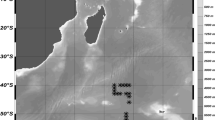Abstract
Measurements of practical salinity are based on conductivity measurements, which are traceable to the conductivity of a defined KCl reference solution. The conductivity of this reference solution must be traceable to the SI in order to state a reliable uncertainty for practical salinity measurements and to guarantee their comparability. Currently, the conductivity ratios from various old standard seawater batches are compared instead. However this method is inadequate on a long time-scale, which is important for oceanography studies, because it lacks a time-invariant reference. Therefore the equivalence of conductivity measurements traceable to primary conductivity standards has been investigated in Euromet project 918. Several European metrology institutes measured the conductivity of a 5 S/m KCl solution and the practical salinity of IAPSO standard seawater. The study estimates relative standard uncertainties to be of the order of 10−4 to 10−3 for such measurements.



Similar content being viewed by others
Notes
IAPSO standard seawater is a product of OSIL (OSIL, Culkin House. C7/C8 Endeavour Business Park, Penner Road, Havant, Hampshire PO9 1QN).
References
UNESCO (1981) Background papers and supporting data on the Practical Salinity Scale 1978. UNESCO Tech Pap Mar Sci (37):7
Bacon S, Culkin F, Higgs N, Ridout P (2007) IAPSO standard seawater: definition of the uncertainty in the calibration procedure, and stability of recent batches. J Atmos Ocean Technol 24:1785–1799. doi:10.1175/JTECH2081.1
Culkin F, Ridout PS (1998) Stability of IAPSO standard seawater. J Atmos Ocean Technol 15:1072–1075. doi :10.1175/1520-0426(1998)015<1072:SOISS>2.0.CO;2
Mantyla AW (1980) Electrical conductivity comparisons of standard seawater batches P29 to P84. Deep-Sea Res 27A:837–846. doi:10.1016/0198-0149(80)90047-3
Brinkmann F, Dam NE, Deák E, Durbiano F, Ferrara E, Fükö J et al (2003) Primary methods for the measurement of electrolytic conductivity. Accredit Qual Assur 8:346–353. doi:10.1007/s00769-003-0645-5
Final report EUROMET project 918 (2007), http://www.euromet.org/projects/search/reports/918_METCHEM_Final.pdf
IAPSO SCOR WG127 (2005) http://www.jhu.edu/scor/wg127.htm
Perkin RG, Lewis EL (1980) The Practical Salinity Scale 1978: fitting the data. IEEE J Oceanic Eng OE-5:9–16. doi:10.1109/JOE.1980.1145441
Knowles CE (1974) Salinity determination from use of CTD sensors. J Phys Oceanogr 4:275–277. doi :10.1175/1520-0485(1974)004<0275:SDFUOC>2.0.CO;2
Acknowledgments
We would like to thank OSIL Standard Seawater Service for placing SSW at our disposal.
Author information
Authors and Affiliations
Corresponding author
Rights and permissions
About this article
Cite this article
Seitz, S., Spitzer, P. & Brown, R.J.C. Consistency of practical salinity measurements traceable to primary conductivity standards: Euromet project 918. Accred Qual Assur 13, 601–605 (2008). https://doi.org/10.1007/s00769-008-0444-0
Received:
Accepted:
Published:
Issue Date:
DOI: https://doi.org/10.1007/s00769-008-0444-0




